Space & Physics
Chandrayaan-3: The moon may have had a fiery past
A magma ocean might’ve wrapped the ancient moon, suggests findings from India’s robotic lunar mission, Chandrayaan-3.

On 23rd August last year, India’s Chandrayaan-3 made history being the first to soft-land on the moon’s south polar region. The landing marked the end of the high-octane phase of the mission. But its next phase was a slow-burner.
Pragyan, the suitcase-sized rover, that hitched a ride to the moon aboard the lander, Vikram, rolled off a ramp onto the lunar surface. It traversed along the dusty lunar surface slowly, at a pace even a snail could beat. Handlers at the Indian Space Research Organization (ISRO) didn’t want the suitcase-sized rover to risk stumbling over a rock or near a ridge, and jeopardize the mission.

The whitish spots are material excavated from the moon’s interior.
Nevertheless, the rover had a busy schedule to stick to. It was to probe the lunar soil, and relay that scientific data back to earth. Pragyan covered 100 meters in two weeks, before it stopped to take a nap ahead of a long lunar night. At the time, the rover’s battery pack was fully charged, thanks to the on-board solar panels soaking up sunlight during the day.
But lunar weather is harsh, especially at the south pole, where Pragyan napped, temperatures can reach as low as -250 degrees centigrade during the night. Added to that, a lunar night lasts two weeks. ISRO deemed Pragyan had only a 1% chance to survive.

Later, the expected happened, when the rover went unresponsive to ISRO’s pings to wake up.
But ISRO said the rover achieved what it was tasked to do. It relayed data all along for two weeks, examining soil from some 23 locations around the mission’s landing point, Statio Shiv Shakti. As months passed by, a slew of discoveries were made. Sulphur was discovered at the south pole, early on while the mission was ongoing. And only a few months ago, Pragyan found evidence of past weathering activity at the south pole.
But since August this year, research teams from ISRO and the Physical Research Laboratory in Ahmedabad, India, reported Pragyan’s most important findings yet – one of which sheds light onto the moon’s origins.
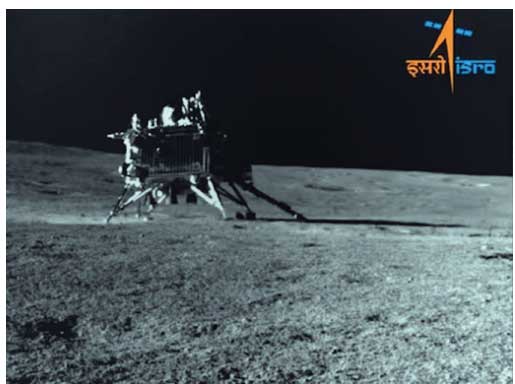
Chandrayaan-3’s Vikram lander, seen from the Pragyan rover’s camera
Moon and the Early Earth
Chandrayaan-3 had carried a radioactive passenger to the moon’s surface – curium-244.
The radioactive curium helps lase the surface: firing alpha particles (which are helium nuclei) at the dusty terrain. Some of these alpha particles bounce off the dust, whereas others evict electrons from the lunar soil, thereby producing x-ray emissions. Keeping watch is the Alpha Particle X-ray Spectrometer (APXS) on-board the Pragyan rover. In August, PRL scientists published findings in the journal, Nature, based on APXS data, reporting discovery of ferroan anorthosite.
It wasn’t the first ever detection per se of ferroan anorthosite. In fact, Apollo 11 had brought back anorthosite rocks to earth, where they were identified as such. That was in 1969, and Apollo sampled them from the equator. Successive missions by the Soviet Union and most recently China affirmed likewise from mid-latitude – equatorial regions as well. But Pragyan’s detection of the rock type was the first ever from the polar region.
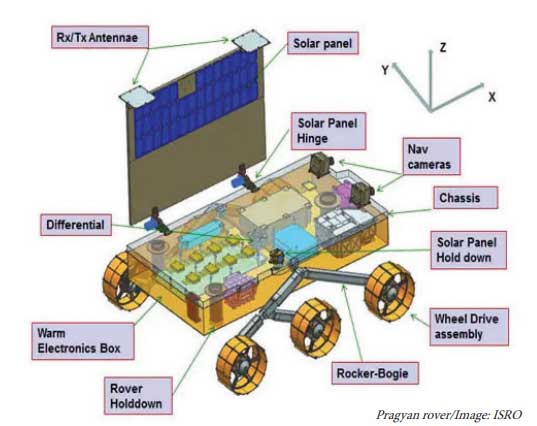
The Pragyan rover’s payload.
Anorthosites are common on earth. In fact, just a year after the Apollo 11 sampled the rock, scientists had evidence of the earth and the moon’s entangled history. The authors noted the similar composition between these rocks, that are geographically widespread. Furthermore, ferroan anorthosite is an igneous rock that forms on earth when hot lava produced in volcanic eruptions cools down.
And scientists had piled up evidence in support of a similar process that underwent on the moon. The anorthosite rocks on the moon are old, in fact, more than 4 billion years ago – a figure close to the earth’s inception with rest of the solar system – around 4.5 billion years. Scientific consensus has been that the moon was formed from remnants of a collision between the early earth and a rogue Mars-sized planetary body.

But the collision energy would have yielded a moon that was molten. A lava blanketing the surface – aka a global magma ocean. As this ocean cooled, minerals amongst which is plagioclase (a class of feldspar) crystallized and formed the anorthosite rocks on the moon. It’s commonly called the lunar magma ocean hypothesis.
When Pragyan treaded over the dusty lunar terrain, it didn’t register the anorthosite as a physical rock per se. Instead, it observed remnants of the rock, as fine powder.
Meteorites beat down rocks to fine powder, as they slam into the moon from space with regular impunity. On earth, the ground is saved by the presence of an atmosphere. But the moon virtually has no atmosphere. Nor does it have water to wear down the rocks. The surface is extremely hot during the lunar day – in fact, when Chandrayaan-3 landed on the moon, the surface temperature was some 50 degrees centigrade. Just a few months ago, Pragyan revealed possible signs of rock degradation from the rims of a crater.
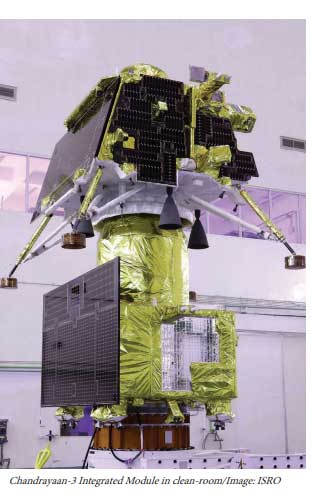
Moon dust opens doors to the past
The fact the moon doesn’t (and can’t) sustain an atmosphere helps it make an attractive destination to learn more about our planet and the satellite’s shared origins. There’s no chemistry to remove traces of the moon’s early evolution from the lunar dust. As such, the dust opens doors to the past.
Space explorations missions soft-landing on the surface study this dust – or sample and shuttle them to earth for scientists to study them in detail.
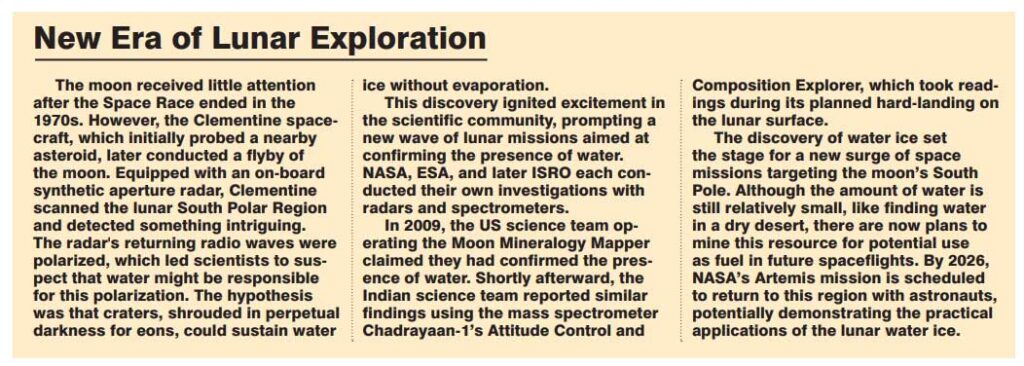
In fact, Pragyan revealed a crater that’s amongst the oldest ever discovered on the moon. The findings were published in the journal, Icarus, in September. Hidden in plain sight, the rover’s navigation camera, NavCam, spotted subtle stretch marks on the surface, that were confirmed later with the Chandrayaan-2 orbiter (which has been orbiting the moon since 2019). In fact, this crater was found buried under nearby craters, most notably the South Pole-Aitkin basin located 350 km away. The basin is the largest impact crater in the entire solar system (some 2,500 km wide and 8 km deep) touted to have formed millions of years ago.
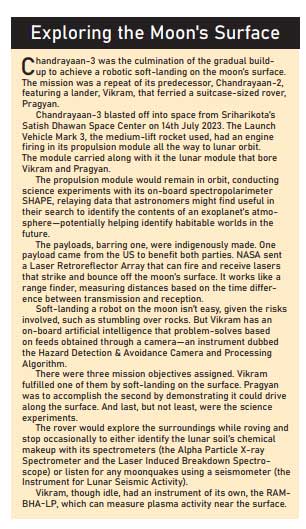
And this became subject to an earlier paper that PRL scientists authored, and was published in August. Pragyan identified material thought to have emerged from the moon’s interior. The APXS instrument picked up unusually high magnesium content in the vicinity. The authors speculate the meteorite that created the basin probably dug up magnesium from deep inside the moon’s upper mantle, and spewed them into Pragyan’s vicinity.
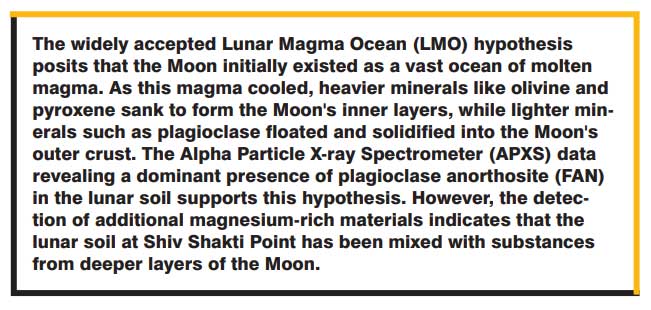
But some experts believe in an alternate explanation. They believe the magnesium might have come from surface rocks in the vicinity, and not from the upper mantle. In fact, the authors acknowledged this amongst other possible alternatives. Nonetheless, the Chandrayaan-3’s findings doesn’t dispute the lunar magma ocean hypothesis either, if not backing it outright. Saying that, the theory lives on to fight another day.
Space & Physics
MIT Pioneers Real-Time Observation of Unconventional Superconductivity in Magic-Angle Graphene
Physicists have directly observed unconventional superconductivity in magic-angle twisted tri-layer graphene using a new experimental platform, revealing a unique pairing mechanism

MIT physicists have unveiled compelling direct evidence for unconventional superconductivity in “magic-angle” twisted tri-layer graphene—an atomically engineered material that could reimagine the future of energy transport and quantum technologies. Their new experiment marks a pivotal step forward, offering a fresh perspective on how electrons synchronize in precisely stacked two-dimensional materials, potentially laying the groundwork for next-generation superconductors that function well above current temperature limits.
Instead of looking merely at theoretical possibilities, the MIT team built a novel platform that lets researchers visualize the superconducting gap “as it emerges in real-time within 2D materials,” said co-lead author Shuwen Sun in a media statement. This gap is crucial, reflecting how robust the material’s superconducting state is during temperature changes—a key indicator for practical applications.
What’s striking, said Jeong Min Park, study co-lead author, is that the superconducting gap in magic-angle graphene differs starkly from the smooth, uniform profile seen in conventional superconductors. “We observed a V-shaped gap that reveals an entirely new pairing mechanism—possibly driven by the electrons themselves, rather than crystal vibrations,” Park said. Such direct measurement is a “first” for the field, giving scientists a more refined tool for identifying and understanding unconventional superconductivity.
Senior author Pablo Jarillo-Herrero emphasized that their method could help crack the code behind room-temperature superconductors: “This breakthrough may trigger deeper insights not just for graphene, but for the entire class of twistronic materials. Imagine grids and quantum computers that operate with zero energy loss—this is the holy grail we’re moving toward,” Jarillo-Herrero said in the MIT release.
Collaborators included scientists from Japan’s National Institute for Materials Science, broadening the impact of the research. The discovery builds on years of progress since the first magic-angle graphene experiments in 2018, opening what many now call the “twistronics” era—a field driven by stacking and twisting atom-thin materials to unlock uniquely quantum properties.
Looking ahead, the team plans to expand its analysis to other ultra-thin structures, hoping to map out electronic behavior not only for superconductors, but for a wider range of correlated quantum phases. “We can now directly observe electron pairs compete and coexist with other quantum states—this could allow us to design new materials from the ground up,” said Park in her public statement.
The research underscores the value of visualization in fundamental physics, suggesting that direct observation may be the missing link to controlling quantum phenomena for efficient, room-temperature technology.
Space & Physics
Atoms Speak Out: Physicists Use Electrons as Messengers to Unlock Secrets of the Nucleus
Physicists at MIT have devised a table-top method to peer inside an atom’s nucleus using the atom’s own electrons

Physicists at MIT have developed a pioneering method to look inside an atom’s nucleus — using the atom’s own electrons as tiny messengers within molecules rather than massive particle accelerators.
In a study published in science, the researchers demonstrated this approach using molecules of radium monofluoride, which pair a radioactive radium atom with a fluoride atom. The molecules act like miniature laboratories where electrons naturally experience extremely strong electric fields. Under these conditions, some electrons briefly penetrate the radium nucleus, interacting directly with protons and neutrons inside. This rare intrusion leaves behind a measurable energy shift, allowing scientists to infer details about the nucleus’ internal structure.
The team observed that these energy shifts, though minute — about one millionth of the energy of a laser photon — provide unambiguous evidence of interactions occurring inside the nucleus rather than outside it. “We now have proof that we can sample inside the nucleus,” said Ronald Fernando Garcia Ruiz, the Thomas A. Franck Associate Professor of Physics at MIT, in a statement. “It’s like being able to measure a battery’s electric field. People can measure its field outside, but to measure inside the battery is far more challenging. And that’s what we can do now.”
Traditionally, exploring nuclear interiors required kilometer-long particle accelerators to smash high-speed beams of electrons into targets. The MIT technique, by contrast, achieves similar insight with a table-top molecular setup. It makes use of the molecule’s natural electric environment to magnify these subtle interactions.
The radium nucleus, unlike most which are spherical, has an asymmetric “pear” shape that makes it a powerful system for studying violations of fundamental physical symmetries — phenomena that could help explain why the universe contains far more matter than antimatter. “The radium nucleus is predicted to be an amplifier of this symmetry breaking, because its nucleus is asymmetric in charge and mass, which is quite unusual,” Garcia Ruiz explained.
To conduct their experiments, the researchers produced radium monofluoride molecules at CERN’s Collinear Resonance Ionization Spectroscopy (CRIS) facility, trapped and cooled them in laser-guided chambers, and then measured laser-induced energy transitions with extreme precision. The work involved MIT physicists Shane Wilkins, Silviu-Marian Udrescu, and Alex Brinson, alongside international collaborators.
“Radium is naturally radioactive, with a short lifetime, and we can currently only produce radium monofluoride molecules in tiny quantities,” said Wilkins. “We therefore need incredibly sensitive techniques to be able to measure them.”
As Udrescu added, “When you put this radioactive atom inside of a molecule, the internal electric field that its electrons experience is orders of magnitude larger compared to the fields we can produce and apply in a lab. In a way, the molecule acts like a giant particle collider and gives us a better chance to probe the radium’s nucleus.”
Going forward, the MIT team aims to cool and align these molecules so that the orientation of their pear-shaped nuclei can be controlled for even more detailed mapping. “Radium-containing molecules are predicted to be exceptionally sensitive systems in which to search for violations of the fundamental symmetries of nature,” Garcia Ruiz said. “We now have a way to carry out that search”
Space & Physics
Physicists Double Precision of Optical Atomic Clocks with New Laser Technique
MIT researchers develop a quantum-enhanced method that doubles the precision and stability of optical atomic clocks, paving the way for portable, ultra-accurate timekeeping.
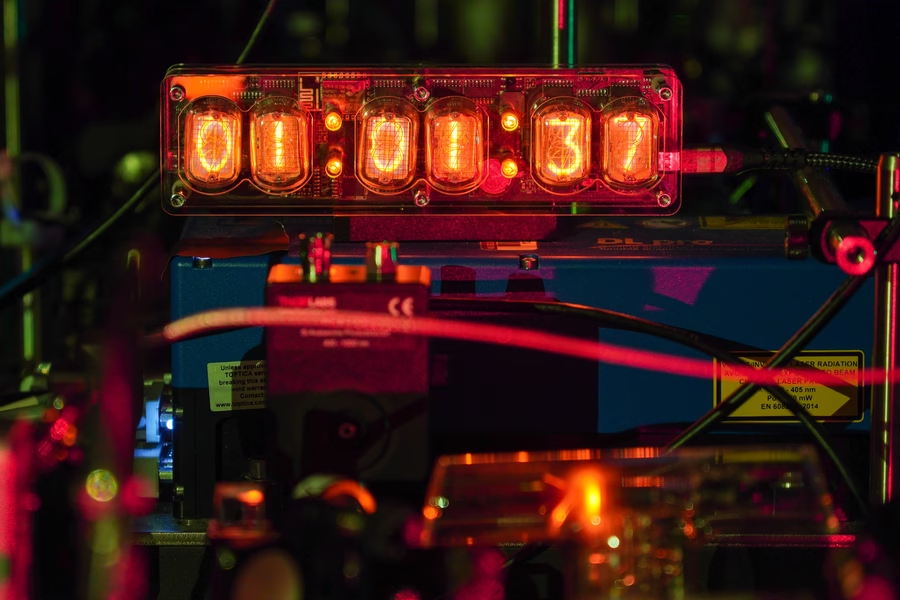
MIT physicists have unveiled a new technique that could significantly improve the precision and stability of next-generation optical atomic clocks, devices that underpin everything from mobile transactions to navigation apps. In a recent media statement, the MIT team explained: “Every time you check the time on your phone, make an online transaction, or use a navigation app, you are depending on the precision of atomic clocks. An atomic clock keeps time by relying on the ‘ticks’ of atoms as they naturally oscillate at rock-steady frequencies.”
Current atomic clocks rely on cesium atoms tracked with lasers at microwave frequencies, but scientists are advancing to clocks based on faster-ticking atoms like ytterbium, which can be tracked with lasers at higher, optical frequencies and discern intervals up to 100 trillion times per second.
A research group at MIT, led by Vladan Vuletić, the Lester Wolfe Professor of Physics, detailed that their newly developed method harnesses a laser-induced “global phase” in ytterbium atoms and boosts this effect using quantum amplification. Vuletić stated, “We think our method can help make these clocks transportable and deployable to where they’re needed.” The approach, called global phase spectroscopy, doubles the precision of an optical atomic clock, enabling it to resolve twice as many ticks per second compared to standard setups, and promises further gains with increasing atom counts.
The technique could pave the way for portable optical atomic clocks able to measure all manner of phenomena in various locations. Vuletić summarized the broader scientific ambitions: “With these clocks, people are trying to detect dark matter and dark energy, and test whether there really are just four fundamental forces, and even to see if these clocks can predict earthquakes.”
The MIT team has previously demonstrated improved clock precision by quantumly entangling hundreds of ytterbium atoms and using time reversal tricks to amplify their signals. Their latest advance applies these methods to much faster optical frequencies, where stabilizing the clock laser has always been a major challenge. “When you have atoms that tick 100 trillion times per second, that’s 10,000 times faster than the frequency of microwaves,” said Vuletić in the statement. Their experiments revealed a surprisingly useful “global phase” information about the laser frequency, previously thought irrelevant, unlocking the potential for even greater accuracy.
The research, led by Vuletić and joined by Leon Zaporski, Qi Liu, Gustavo Velez, Matthew Radzihovsky, Zeyang Li, Simone Colombo, and Edwin Pedrozo-Peñafiel of the MIT-Harvard Center for Ultracold Atoms, was published in Nature. They believe the technical benefits of the new method will make atomic clocks easier to run and enable stable, transportable clocks fit for future scientific exploration, including earthquake prediction, fundamental physics, and global time standards.
-

 Space & Physics6 months ago
Space & Physics6 months agoIs Time Travel Possible? Exploring the Science Behind the Concept
-

 Know The Scientist6 months ago
Know The Scientist6 months agoNarlikar – the rare Indian scientist who penned short stories
-

 Know The Scientist5 months ago
Know The Scientist5 months agoRemembering S.N. Bose, the underrated maestro in quantum physics
-

 Space & Physics3 months ago
Space & Physics3 months agoJoint NASA-ISRO radar satellite is the most powerful built to date
-

 Society5 months ago
Society5 months agoAxiom-4 will see an Indian astronaut depart for outer space after 41 years
-

 Society5 months ago
Society5 months agoShukla is now India’s first astronaut in decades to visit outer space
-

 Society5 months ago
Society5 months agoWhy the Arts Matter As Much As Science or Math
-

 Earth5 months ago
Earth5 months agoWorld Environment Day 2025: “Beating plastic pollution”


















